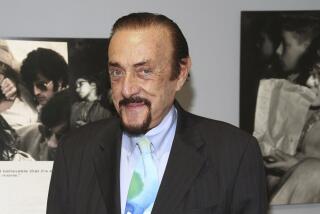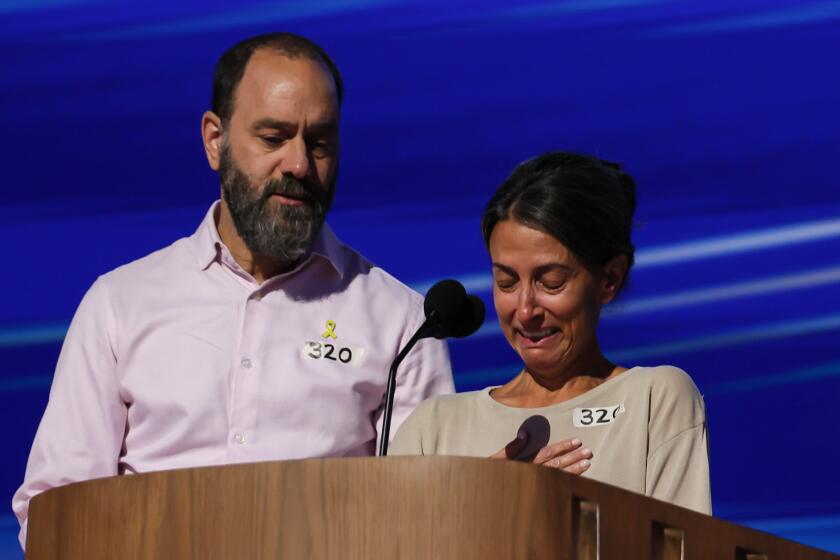How the Search for Scientific Justice Became a Trial by Ordeal
Not since the security investigation of Robert Oppenheimer, the UC Berkeley physicist who guided development of the atomic bomb, has the question of a scientist’s character so galvanized national attention. The government found Oppenheimer’s friendships and politics so troubling that it revoked his top-secret clearance. The misconduct case involving Nobel laureate David Baltimore spawned years of federal investigations and congressional confrontations that, like the Oppenheimer security hearings, stirred fierce and still unreconciled partisan passions.
But if the matter of Oppenheimer in 1953, with its red-baiting and Cold War politics, was about national loyalty, the more recent matter of biologist Baltimore was about trust--trust in the honesty of researchers, in the nature of the scientific process and in the ability of scientists to safeguard its integrity. It highlighted an equally political struggle for the control of science.
Today, Baltimore, winner of the 1975 Noble Prize for medicine, is president of the California Institute of Technology and head of the nation’s effort to find a vaccine against AIDS. But barely three years ago, Baltimore was a scientist in disgrace, exiled to a research laboratory at the Massachusetts Institute of Technology, after resigning as president of Rockefeller University. His handling of misconduct allegations against a colleague was a synonym for the flawed elitism of establishment science.
The rise, fall and restoration of David Baltimore is at the heart of a deeply troubling chapter in contemporary science, and in the first full telling of that episode, Daniel J. Kevles, a distinguished science historian at Caltech, has written a brilliant, unsparing and meticulously researched account of a controversy that helped reshape how scientific misconduct is handled in the United States.
“The Baltimore Case” is the story of how a search for scientific justice can mutate into a brutal struggle for political advantage. With an admirable mastery of a complex political and technical record, Kevles has assembled the history of a single experiment, the lives that it derailed, and the broader questions it raised about how scientists should account for their actions to the public that pays for their work.
Kevles, the author of well-regarded histories of American physics and of the eugenics movement in the United States, has formidable credentials as an independent-minded scholar. From his reading of the record, he concludes that Baltimore and his colleagues were the victims of a medieval trial by ordeal, in which any protestation of innocence or effort to contest the accusations was taken by inquisitors as evidence of sin.
The failure of both science and government to handle accusations of scientific misconduct without violating the civil rights of scientists is at the heart of the Baltimore case, and its legacy still haunts the effort to effectively police publicly-funded research. For even if Baltimore and his colleagues actually had been guilty of fabricating data--and they were not--their ordeal, Kevles shows, is something that a government should never allow and that a community of scientists should never condone.
When it began in the spring of 1986, the controversy had little to do with Baltimore himself but centered rather on one of his collaborators, an MIT immunologist named Thereza Imanishi-Kari, whose supporting experiments were crucial to a research paper that they had written together. The paper, published in Cell, offered striking insight into how the immune system might be manipulated through genetic engineering.
A post-doctoral fellow in Imanishi-Kari’s laboratory named Margot O’Toole soon began to raise questions about the reliability of a key reagent used in the experiment after she spent months failing to make it work as described in the published research. When she discovered 17 pages of lab notes that appeared to contradict the published results, her doubts about her own competence as a scientist were transformed into suspicions that Imanishi-Kari had faked the data.
At first, she only called attention to technical errors in Imanishi-Kari’s work, and that led to an investigation by Tufts University--the first in a series of nonjudicial proceedings over a decade, mostly conducted without granting the accused the basic constitutional protections of a trial or the administrative safeguards of a grievance procedure.
The scientists involved in the Cell paper grudgingly acknowledged the technical errors but considered them too minor to correct publicly. O’Toole’s broader questions about the paper’s conclusions, however, were legitimate matters of scientific interpretation that could be resolved only by further research, they said. But the scientists had little inclination to do the research themselves. If they had promptly published a correction, the matter in all likelihood would have ended there.
Instead, the disagreement continued to simmer until it came to the attention of two snail biologists at the National Institutes of Health, Walter Stewart and Ned Feder, who had appointed themselves public inquisitors of scientific fraud. They, in turn, gained the ear of Michigan congressman John Dingell, who was rightly intent on making researchers and universities take the problem of scientific misconduct more seriously. They worked hand-in-hand with congressional investigators to probe the Cell paper.
Congressional hearings were convened. The Department of Health and Human Services, which had already started an investigation of its own, stepped up its efforts. Imanishi-Kari’s grants were canceled. At Dingell’s request, her laboratory notebooks were subjected to a Secret Service forensic analysis of the sort more normally reserved for evidence of a political assassination. Critical reports were leaked to the press.
As the dispute became more adversarial--and more public--initial questions of error and interpretation hardened into accusations of fraud. The stakes rose from simple professional embarrassment to potential criminal charges. And Baltimore, who insisted that politicians had no business trying to police technical scientific disputes, became the lightning rod for public censure.
The headlines depicted Imanishi-Kari and Baltimore, who defended her, as betrayers of truth and scientific ideals. Her sloppy record-keeping, one prominent biologist said, was at best an insult to science and at worst evidence of fraud. Baltimore’s actions undermined the image of science and threatened its congressional support, other colleagues said. O’Toole’s courage in coming forward as a whistle-blower--which was commonly thought to have cost O’Toole her job, her home and her ability to work as a scientist--garnered her ethics awards.
At the same time, complaints about the unfairness of the proceedings were dismissed. The accused were denied a serious look at the evidence against them or the opportunity to confront their accusers. Indeed, they were not even invited to Dingell’s first congressional hearing in 1988, at which O’Toole aired her allegations and a former co-researcher with Imanishi-Kari named Charles Maplethorpe testified that he had seen falsified data in Imanishi-Kari’s lab. In 1994--eight years after suspicions first arose about her work--the Department of Health and Human Services ruled that Imanishi-Kari had fabricated the data. By that time, Baltimore had tied his reputation so closely to hers that it was as if he himself had been found guilty.
Not until 1995 did Imanishi-Kari and her lawyers have the opportunity to cross-examine the witnesses against her. Within months, the case collapsed.
A federal administrative review board threw out the charges on appeal. It was one in a series of reversals that exonerated prominent researchers accused of misconduct because federal investigations had been botched. Indeed, by the time the charges against Imanishi-Kari reached the federal review board that year, the U.S. Office of Research Integrity already had lost or abandoned four of its most highly publicized cases of scientific misconduct.
“Much of what ORI presented [against Imanishi-Kari] was irrelevant, had limited probative value, was internally inconsistent, lacked reliability or foundation, was not credible or not corroborated, or was based on unwarranted assumptions,” the panel said.
Virtually overnight, accused and accusers reversed roles. Dingell the crusader became Dingell the bully. The whistle-blower was stripped of her spotlight. The public price that Baltimore had paid for his defense of Imanishi-Kari--his tarnished reputation, his resignation as president of Rockefeller University and his exile from public life--was too much to pay. What had seemed “rough justice” now was a profound miscarriage.
Kevles notes at the outset of his book that Imanishi-Kari was never convicted anywhere but in the court of public opinion. It is critical here to note the role that Kevles played as a kind of literary appellate judge in reversing that conviction.
In May 1996, a month before the appeals panel ruling, Kevles published in the New Yorker an influential narrative of the scandal that went against the grain of what then was the conventional wisdom about Imanishi-Kari’s guilt and Baltimore’s intransigence.
When the appeals panel overturned the charges--finding the published research “as a whole rife with errors of all sorts” but not with fabrication or fraud--it seemed to endorse the broader conclusions that Kevles had articulated about the case.
Moreover, as head of the Caltech faculty senate, Kevles was approached by colleagues for advice when, several months later, Baltimore emerged as a leading candidate for the post of university president. So Kevles, who first vouched for Baltimore’s character to the casual reading public, then offered the same judgment to a faculty search committee and to his university colleagues.
It is the same verdict he now renders for history.
Certainly, he is no apologist. He apportions blame widely and is unflinching in his character assessments, from Baltimore’s autocratic self-assurance and Imanishi-Kari’s prickly eccentricities to O’Toole’s self-righteousness.
He is hardest on O’Toole. Her recollection of key events and conversations often is sharply contradicted by other participants’ and in some instances by her own previous testimony. Her sense of conspiracy and cover-up seemed to expand to encompass whoever disagreed with her shifting account of events. He leaves the impression that O’Toole found as the martyred whistle-blower a level of scientific respectability that eluded her in the laboratory.
At the same time, Kevles writes, the actual investigations of the experiment--especially the Secret Service examination of Imanishi-Kari’s notebooks--were hopelessly flawed.
To document his assertions, Kevles explores a level of scientific detail, at times overwhelming to a casual reader, that is nonetheless crucial to understanding how the dispute could go so wrong. For almost no one seems to have completely understood the experimental raw material of the contested paper--not the whistle-blower who so convincingly questioned its veracity, the prominent scientists who supported her, the investigators who were so intent on proving that its data had been fabricated or the reporters who gave the case so much publicity.
Indeed, not even the scientists most directly involved in the contested research paper could be said to have mastered all the technical intricacies of what their collaborators in other laboratories had accomplished. If congressional and federal investigators did not completely grasp all the fine points of transgenic mice, subcloning data, hybridomas and radiation counts, they turned to things that anyone could understand--pride, arrogance, dishonesty and cover-up. And, intentionally or not, Kevles writes, they arranged their evidence to fit that pattern.
In their zeal, the investigators were guilty of the kind of research for which they had condemned Imanishi-Kari. Selectively highlighting some items as forensic evidence of fabrication and rejecting exculpatory items, they tailored their inquiry to fit their preconceptions of fraud.
At its most fundamental, Kevles writes, the dispute reflected a disagreement over the nature of science itself and the process by which it progresses. In the end, Kevles shares David Baltimore’s view of the philosophical character of science:
“The scientific literature is a conversation among scientists,” Baltimore testified before the Dingell subcommittee. “It is crucial to remember, and often forgotten, that a paper does not claim to be an absolute assurance of truth, only a moment’s best guess by one group of investigators. Because all of these judgments are less than wholly objective, another investigator might have come to a different conclusion using the same data. In a real sense, a scientific paper is a subjective product.”
More to Read
Sign up for Essential California
The most important California stories and recommendations in your inbox every morning.
You may occasionally receive promotional content from the Los Angeles Times.










